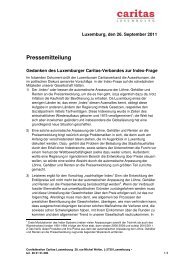Sozialalmanach - Caritas Luxembourg
Sozialalmanach - Caritas Luxembourg
Sozialalmanach - Caritas Luxembourg
Create successful ePaper yourself
Turn your PDF publications into a flip-book with our unique Google optimized e-Paper software.
PAYGO and funding as methods of financing. Virtually all other European countries have<br />
also introduced fiscal incentives to encourage people to take up supplementary private<br />
pension insurance, fairly successfully in Austria and Spain. In the 1990s, a number of<br />
countries, notably Belgium, France, Ireland, the Netherlands and Portugal, have started to<br />
build up reserve funds in order to maintain adequate pension provision when the baby-boom<br />
generation retires. Also changes in indexation rules have helped to reduce future pension<br />
reliabilities. In Austria, Germany, Italy and Spain restrictions have gone hand in hand<br />
with attempts to upgrade minimum retirement guarantees. Measures to combine work<br />
and retirement via partial pension benefits have been introduced in Austria, Belgium,<br />
Denmark and Germany. In Western Europe, one of the most profound reforms was enacted<br />
by Sweden in the mid-1990s, which introduced a small mandatory funded element and<br />
transferred an important part of the risk associated with aging to retirees. The latter was<br />
done by indexing future benefits to the life expectancy of the retiring cohort and by linking<br />
future benefits to net wages. Benefits will be lower if life expectancy continues to increase<br />
and net wages continue to grow slow, but the reform also continued to ensure a universal<br />
guaranteed pension for low-income pensioners 26 . The Swedish legislation has also heavily<br />
influenced reforms in other countries, like Italy, Latvia and Poland 27 . And while Germany<br />
and the United Kingdom are about to raise the retirement age, Finland has developed<br />
policy approaches to improve occupational health, work ability and well-being of aging<br />
workers, in order to keep older workers in the workforce as long as possible 28 .<br />
Social services have experienced a comeback lately. Spending on childcare, education,<br />
health, and elderly care, alongside training and employment services, has increased<br />
practically everywhere in Western Europe over the past decade. Almost a fifth of all jobs<br />
created in the EU between 1995 and 2001 occurred in the health and social services sector<br />
as aging and longevity make demands on professional care that working families can no<br />
longer meet. Social services and family policies have also witnessed some innovation in<br />
both substantive and organizational terms, with a view to responding to the rising needs of<br />
the elderly population, the changing gender division of labour and new forms of poverty<br />
and exclusion 29 .<br />
All welfare states have indisputably been weakening their traditional male breadwinner<br />
bias. In Scandinavia the expansion of services to families began in the 1970s in tandem<br />
with the rise in female labour supply. It was in large part this policy of socializing caring<br />
responsibilities that catalysed the dual-earner norm. In most other European countries,<br />
26 Palme (2005).<br />
27 Ferrera & Gualmini (2000); Fultz & Ruck (2001).<br />
28 Clark & Whiteside (2003); Immergut et al. (2007).<br />
29 Hemerijck (forthcoming).<br />
159








